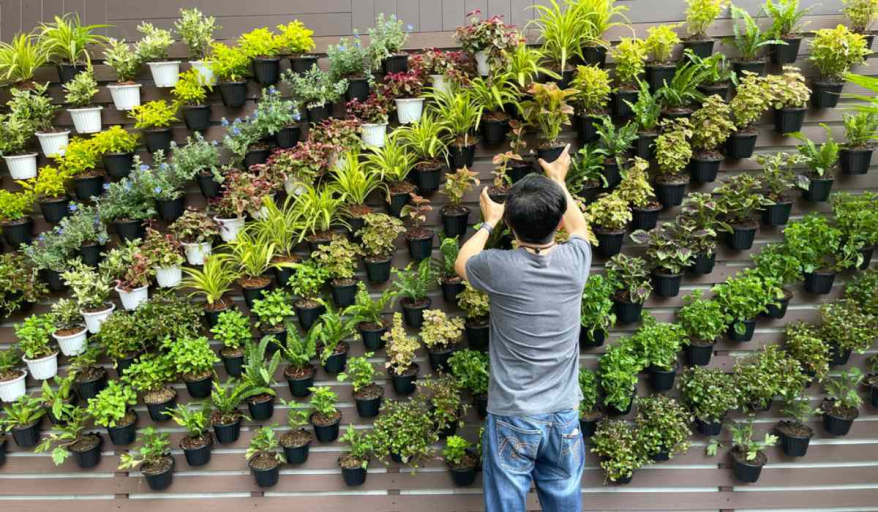Vertical gardening is an innovative technique involving growing plants vertically, utilizing walls, fences, or specially designed structures. This method offers numerous advantages over traditional horizontal gardening, making it an ideal solution for small spaces, urban environments, or anyone seeking to maximize their gardening potential. In this article, we will delve into the benefits of vertical gardening and provide practical tips on implementing it successfully.
Advantages of Vertical Gardening
1. Maximizing Space Efficiency
Vertical gardening allows you to maximize limited space. You can grow various plants without requiring large horizontal areas by utilizing vertical surfaces, such as walls or trellises. It is particularly advantageous for urban dwellers, apartment owners, or individuals with small yards.
The love of gardening is a seed once sown that never dies, but never grows to the enduring happiness that the love of gardening gives. – Gertrude Jekyll2. Enhancing Aesthetics
Vertical gardens add a visually appealing element to any space. Whether you create a living wall with cascading foliage or cultivate a vertical vegetable garden, the lush greenery and vibrant colors will transform your surroundings into a natural oasis. Consider suitable plants for vertical gardening. Vertical gardens also provide privacy, serve as sound barriers, and help regulate temperatures in urban areas.
3. Increasing Accessibility and Convenience
Vertical gardening makes tending to plants more accessible and convenient. Since the plants are grown at various heights, you can easily reach them without bending down or kneeling. It makes tasks such as planting, pruning, and harvesting more comfortable, especially for individuals with mobility or back problems.
4. Promoting Better Plant Health
Vertical gardening promotes better air circulation and sunlight exposure for your plants. It lessens the risk of diseases caused by excessive moisture or lack of airflow. Additionally, vertical structures can support climbing plants, ensuring they grow upright and preventing damage caused by sprawling on the ground.
5. Efficient Water Usage
Vertical gardening allows for efficient water usage. Water can be directed precisely to the plants' root zones using drip irrigation or hydroponics, minimizing wastage. Vertical structures also prevent water runoff, allowing the plants to absorb moisture effectively and reducing the need for frequent watering.
6. Pest and Disease Control
Vertical gardening can help with pest and disease control. Lifting the plants off the ground creates a physical barrier that deters pests like slugs or snails. Additionally, improved airflow and sunlight exposure can reduce the risk of fungal diseases that thrive in damp environments.
How to Implement Vertical Gardening
1. Selecting the Right Location
Choose a location that receives adequate sunlight for the plants you intend to grow. Consider the vertical surface's structural integrity and ensure it can support the weight of the garden. Also, consider factors such as access to water and the level of protection from wind or extreme weather conditions.
2. Choosing the Suitable Plants
Select plants suitable for vertical gardening. Lightweight plants, climbing plants like tomatoes, cucumbers, or beans are excellent choices. Additionally, consider trailing plants, herbs, or flowers that will thrive in the vertical environment. Research the specific requirements of each plant and ensure they are compatible with vertical growth.
3. Building or Buying Vertical Structures
Decide whether you want to build your vertical structure or purchase pre-made options. DIY vertical gardens just like DIY project using peat moss can be constructed using trellises, pallets, or hanging planters. Alternatively, ready-made systems such as living wall kits or modular vertical gardens are available for purchase, offering convenience and ease of installation.
4. Providing Proper Support and Irrigation
Ensure your vertical garden has adequate support and irrigation systems. Use sturdy supports like trellises, wire mesh, or vertical planters to secure the plants upright. Install an efficient irrigation system, such as drip irrigation or a self-watering planter, to provide consistent moisture to the plants.
5. Regular Maintenance and Care
Regularly monitor and maintain your vertical garden. Prune and train the plants as needed to ensure they grow vertically and stay clean. Check the irrigation system regularly to ensure its proper functioning and adjust it based on the plant's water requirements. Periodically inspect the plants for pests or diseases and take appropriate measures to control them.
Conclusion
Vertical gardening offers a range of advantages, from maximizing space efficiency to enhancing aesthetics and promoting plant health. Following these steps in this article, you can successfully implement vertical gardening and enjoy its benefits. Embrace this innovative technique and transform your gardening experience today.



